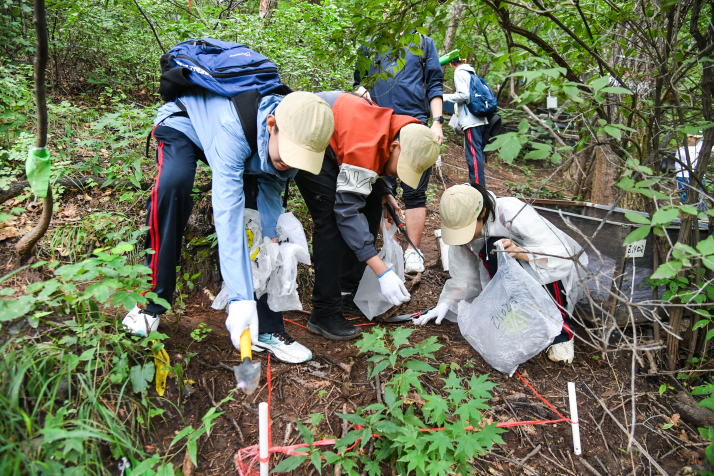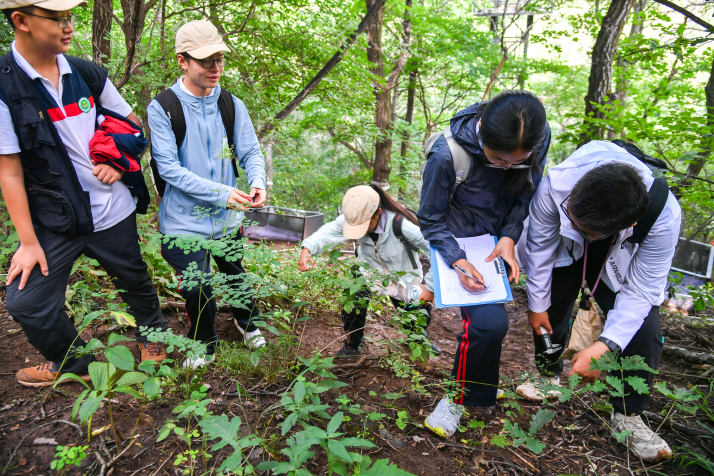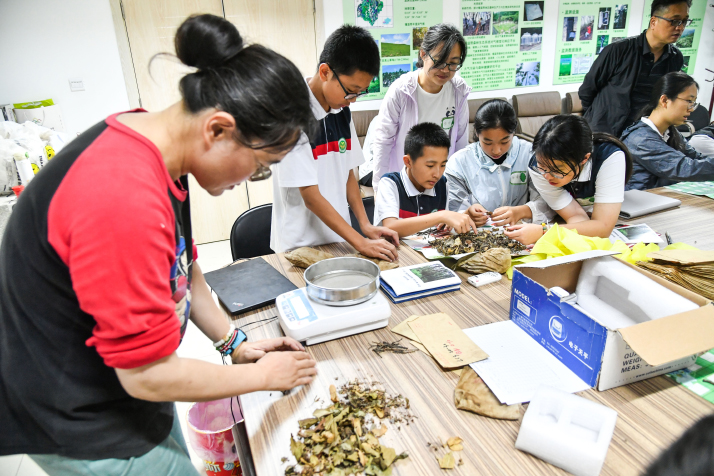| Lifestyle |
| Middle school students learn research skills in Beijing forest | |
|
|
 Students collect plant litter for research as part of a study tour in a forest on the outskirts of Beijing on August 12
During the recently concluded summer vacation, students from Beijing's Daxing No.1 Middle School discovered their city, one of China's most populous, is also home to many large forest ecosystems. On a two-day visit to the Xiaolongmen National Forest Park in Beijing's Mentougou District from August 12 to 13, the students learned about the city's forest ecology under the guidance of researchers with the Beijing Forest Ecosystem Research Station of the Chinese Academy of Sciences.  Students collect and record data on understory renewal in the Xiaolongmen National Forest Park in Beijing's Mentougou District on August 13
Scientific exploration Co-organized by the school, the research station and Beijing Municipal Forestry and Parks Promotion Center, the students' visit was made ahead of the second National Ecology Day, marked on August 15. Science-related holiday study tours for elementary, middle and high school students have become increasingly popular in recent years as an alternative to traditional holiday activity or study programs. The research station organized these study tours to impart knowledge and research skills to students. Despite being just a two-day tour, researcher Wang Yang from the research station and his colleague Bai Fan already started designing the program in May.  Bai Fan (first left), a researcher with the Beijing Forest Ecosystem Research Station of the Chinese Academy of Sciences, teaches students how to sort and count forest litter by type on August 12
Before the students arrived at the station, the two researchers had offered the students more than 60 journal essays, with some on research methods and some based on observation data from forest ecosystem research stations around the country. The pair told Beijing Review that science literature study is part of this scientific exploration. The students further learned about related research methods through field activities in the forest. The two researchers designed three research topics from which the students could choose: investigation of plant communities in deciduous broad-leaved forests in warm temperate zones; identification of seasonal variations in forest litter; and exploration of understory renewal. In addition to supervising the students' field research, the two also gave in-classroom lectures on forest ecology and guided students to conduct experiments. Deep in the forest The most striking aspect of this trip was undoubtedly the students' experience of conducting hands-on field research, which usually only undergraduate or even postgraduate students engage in, under the guidance of scientists. According to Wu Qiang, Vice Principal of the middle school, more than 100 Grade One students applied for the 20 places in the program, and places were awarded based on their biology examination scores. Soon after arriving at the forest park on August 12, the 20 students discovered the mountain paths to be more rugged and uneven than they had imagined. The paths through the forest surrounding the research station were formed only by the daily trekking of researchers and require careful navigation. The group also encountered a swarm of wasps, underscoring the stark contrast between scientific exploration and leisurely sightseeing in the forest. Through field observations, the students gained basic knowledge of plant species in deciduous broad-leaved forests in warm temperate zones, and with explanations by Bai, they came to understand the significance of the seemingly tedious research for ecological protection. After collecting leaf litter samples in the forest and returning to the classroom, the students were required to sort and select not only their own litter samples, but also those collected by the research station for the whole month of July. They learned that a large amount of repetitive work is the routine for forest scientists. The visit came to an end on the afternoon of August 13, when the statistical work for litter samples was also completed. Scientists from the research station arranged group discussions according to the students' preferences, provided them with guidance on how to write scientific essay outlines, and asked them to summarize their explorations. Forest coverage in Beijing has increased to 44.9 percent today from 41.6 percent in 2014, and the city holds more than 2,000 ecology-related activities every year, providing millions of residents with opportunities to visit forests. While the students' visit to the research station is among the first such hands-on, in-depth learning tours for younger students, it is expected that similar activities will be held in the future to help Beijing's children learn more about ecology and scientific research methodology. Copyedited by G.P. Wilson Comments to weiyao@cicgamericas.com |
|
||||||||||||||||||||||||||||||
|